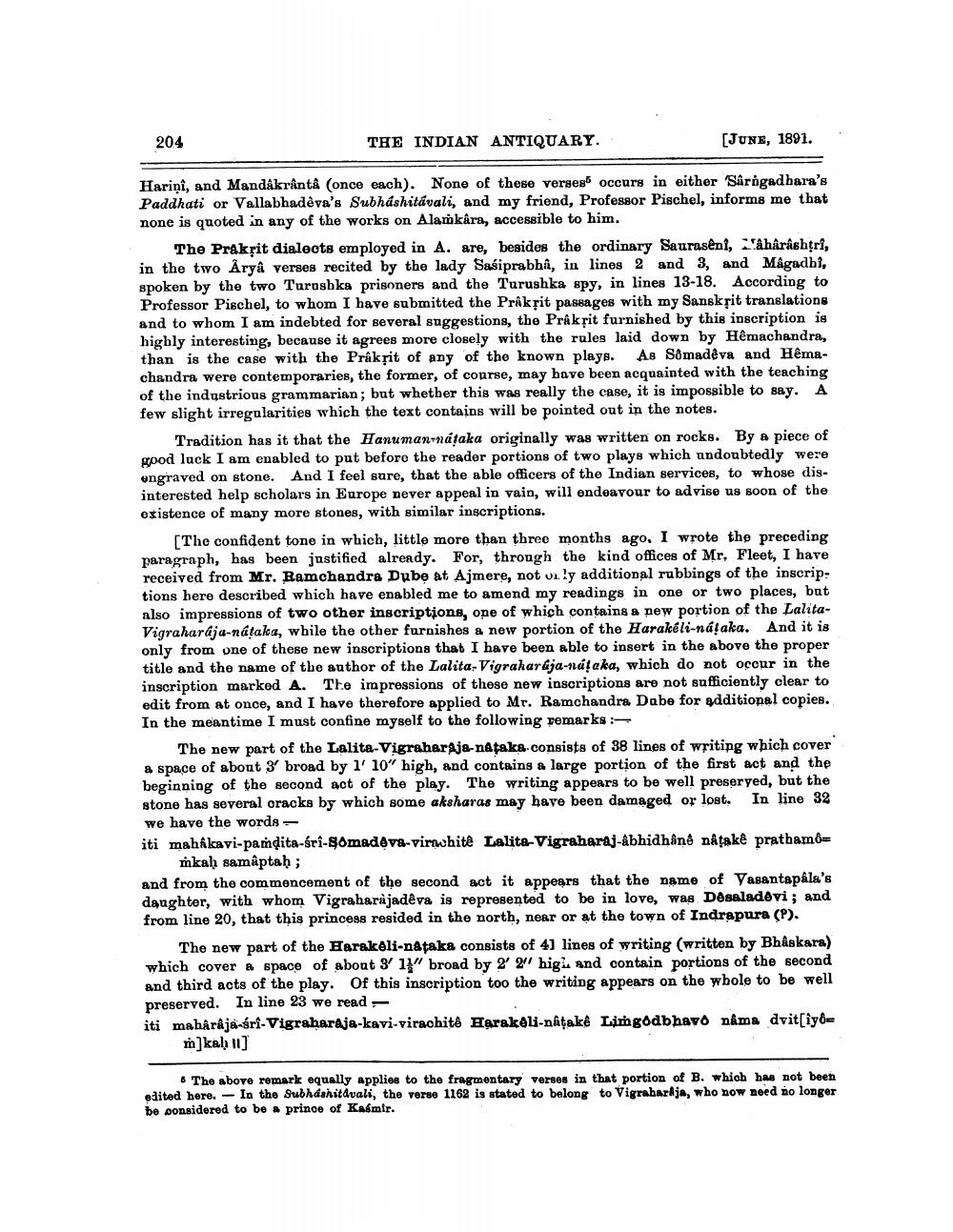________________
204
THE INDIAN ANTIQUARY.
[JUNE, 1891.
Hariņi, and Mandåkrântâ (once each). None of these verses occurs in either Sârigadbara's Paddhati or Vallabhadeva's Subhashitávali, and my friend, Professor Pischel, informs me that none is quoted in any of the works on Alamkara, accessible to him.
The Prakṣit dialects employed in A. are, besides the ordinary Saurasêni, 'âhârâshtri, in the two Åryâ verses recited by the lady Saśiprabha, in lines 2 and 3, and Magadb}, spoken by the two Turushka prisoners and the Turushka spy, in lines 13-18. According to Professor Pischel, to whom I have submitted the Prakṣit passages with my Sanskrit translations and to whom I am indebted for several suggestions, the Prakrit furnished by this inscription is highly interesting, because it agrees more closely with the rules laid down by Hêmachandra, than is the case with the Prakrit of any of the known plays. As Sômadeva and Hêmachandra were contemporaries, the former, of course, may have been acquainted with the teaching of the industrious grammarian; but whether this was really the case, it is impossible to say. A few slight irregularities which the text contains will be pointed out in the notes.
Tradition has it that the Hanuman-nátaka originally was written on rocks. By a piece of good luck I am enabled to put before the reader portions of two plays which undoubtedly were ungraved on stone. And I feel sure, that the able officers of the Indian services, to whose disinterested help scholars in Europe never appeal in vain, will endeavour to advise us soon of the oxistence of many more stones, with similar inscriptions.
[The confident tone in which, little more than three months ago. I wrote the preceding paragraph, has been justified already. For, through the kind offices of Mr. Fleet, I have received from Mr. Ramchandra Dube at Ajmere, not only additional rubbings of the inscriptions here described which have enabled me to amend my readings in one or two places, but also impressions of two other inscriptions, one of which contains a new portion of the LalitaVigraharaja-nataka, while the other furnishes a new portion of the Harakéli-náļaka. And it is only from one of these new inscriptions that I have been able to insert in the above the proper title and the name of the author of the Lalita: Vigraharja-nálaka, which do not occur in the inscription marked A. The impressions of these new inscriptions are not sufficiently clear to edit from at once, and I have therefore applied to Mr. Ramchandra Dube for additional copies. In the meantime I must confine myself to the following remarks S
The new part of the Lalita-Vigraharaja-nAtaka.consists of 38 lines of writing which cover & space of about 3 broad by 1' 10" high, and contains a large portion of the first act and the beginning of the second act of the play. The writing appears to be well preseryed, but the stone has several oracks by which some aksharas may have been damaged or lost. In line 32 we have the words - iti mahîkavi-pandita-sri-gomadova-virhitê Lalita-Vigraharaj-Abhidhånd nåtaké pratham
mkah samậptaḥ; and from the commencement of the second act it appears that the name of Vasantapala's daughter, with whom Vigraharajadêva is represented to be in love, was Dosaladevi; and from line 20, that this princess resided in the north, near or at the town of Indrapura (P).
The new part of the Harakali-nataka consists of 41 lines of writing (written by Bhaskara) which cover a space of about 3 ly" broad by 2' 2'hig and contain portions of the second and third acts of the play. Of this inscription too the writing appears on the wbole to be well preserved. In line 23 we read - iti mahårája-sri-Vigrahardja-kavi-virachite Harakali-natake Limgodbhav6 nama dvitsiye
m]kalı 11]
6 The above romark equally applies to the fragmentary verses in that portion of B. which has not been edited here. In the Subhdahitdvali, the verse 1162 is stated to belong to Vigrabarkja, who now need no longer bo ponsidered to be prince of Kasmir.




